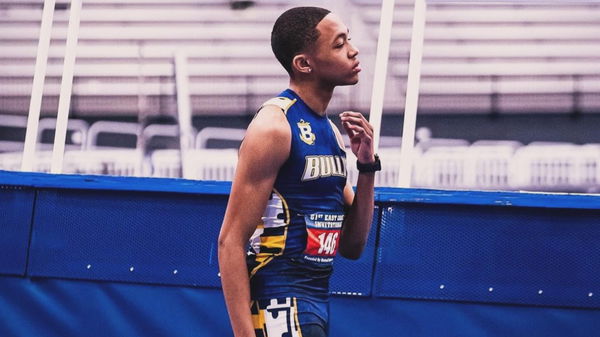

After an incredible run at the Penn Relays presented by Toyota, Quincy Wilson is back in the headlines. Early on Saturday morning, Bullis School managed to hold off time through sophomore Quincy Wilson’s best 400-meter split in Penn Relays annals. With a 44.69 split, Wilson crushed the last 400 meters to move Bullis School back to third. But what happened when Wilson went for the extra step?
While the relay finals sealed his place among track and field’s most promising young athletes, it also sparked questions about the potential physical toll that his rigorous training program might be having on him. Coaches and supporters are debating the best ways to assist Wilson as he pushes the limits of his speed while also sheltering him from injury and exhaustion. The debate ensued as Rori Dunk posted Quincy’s record in the Penn Relays. But this is not the first time he has shot to the news with his fiery run.
At the 2024 New Balance Indoor Nationals in Boston, Wilson set a junior world record in the indoor 400 meters with a time of 45.76 seconds. He also leads the national lists at 500 (1:01.27) and 600 (1:17.36), both soph-class records. He boasts top-10 marks at 200 (21.02) and 300 (33.11). So how did he approach his record-making race? “Getting into the starting blocks, I’m taking everything slow, going through my race strategy in my head. When I got out of the blocks, I didn’t stay on my drive phase too long. I knew I had a plan and I had to get back on my plan…It all came together, what I’ve been working for.”
ADVERTISEMENT
Article continues below this ad
.@QuincyWilson5 with another amazing split in the finals of the 4x400m
He split 44.69! The 2nd fastest split in high school history only behind himself ! pic.twitter.com/DBXIppv51r
— RoriDunk (@FitzDunk) April 27, 2024
Wilson’s constant outstanding achievements on the track have cemented his status as a formidable sprinter. But as his record of accomplishments mounts, supporters swarmed the comment section with words of support. They worry more about the potential consequences of pushing a rookie too soon.
Too early, too fast? Fans argue
Notably, there have been constant talks about college athletes getting overworked for the honor of their respective schools. This might end up finishing their careers prematurely. The very emotion was reflected when a fan shared Rori Dunk’s tweet post and mentioned:
Lord please protect this young man. Keep good people around him. People that wont take advantage of him, people that will protect him from the sharks circling around him.
I pray for his health and happiness in the years to come. https://t.co/61lnq465KT
— LaMonte Vaughn Jr. (@KoachVaughn) April 28, 2024
Fans also voiced worries and aspirations for Quincy Wilson’s future throughout the conversations around his comeback. One supporter highlighted the significance of positive influences in Wilson’s route by writing, “Amen, this young man has a great future. I Pray for the Right people in his life, to guide and not to manipulate”. But is it really something to be concerned about?
ADVERTISEMENT
Article continues below this ad
There have been examples of teen sensations making big in their career later on. Sydney McLaughlin-Levrone is a dazzling example. She made her first Olympic team at 16. However, getting exposed to high-intensity races earlier undoubtedly exposes one to potential injuries at a tender age which can be disastrous. Keeping that in mind, another fan responded, “Hopefully he is allowed a week or two off from competition to recover,” acknowledging the necessity of relaxation and recovery time amid demanding competitive schedules. But Wilson seems to be made of different grains as his coach Joe Lee pointed out.
Hopefully he is allowed a week or two off from competition to recover
— Athletics Westchester (@AthWestchester) April 28, 2024
ADVERTISEMENT
Article continues below this ad
“Most kids are afraid to push through unknown barriers. He doesn’t even have barriers,” Lee said of Quincy. Interestingly, Lee is one coach who not only pushes Quincy to track excellence but academic as well.
Wilson once came up with a B-plus on a progress report. Lee said that was unacceptable and he should turn that into an “A”. So, Wilson raised his grade from 89 to 95! Referring to this importance of the coach that put Wilson’s growth, one user commented, “Exactly that coach”. Lastly, one user could not agree more to Rori Dunk’s post as they wrote, “This tweet is so important! 🙏🏾.” But amid all, Quincy keeps the matter simple and straight. “Keep training hard, and get great results,” he says. We hope this hard training prepares him for the long run instead of weighing him down.
ADVERTISEMENT
ADVERTISEMENT
ADVERTISEMENT
